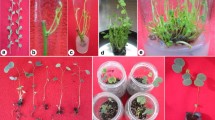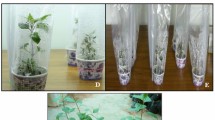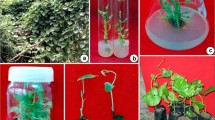Abstract
Key message
The addition of cytokinin drastically increases shoot proliferation in Melaleuca. Individual in vitro shoots previously treated with BA showed better rooting development than BA-free culture medium. Reduction of the osmotic potential in the culture medium decreased dehydration of micropropagated plantlets.
Abstract
Melaleuca alternifolia, known as tea tree, is an Australian medicinal plant widely used in the cosmetic and pharmaceutical industries due to its antibacterial and antifungal properties. Propagation of Melaleuca is limited due to low rates of seed germination and multiplication and the poor rooting of stem cuttings. Thus, micropropagation can be an alternative to the propagation of this woody medicinal species. In this study, different concentrations of 6-benzyladenine (BA) (0, 0.55, 1.11 and 2.22 µM) were tested during the in vitro multiplication phase. It was observed that even the lowest concentration of BA (0.55 µM) could drastically increase the multiplication rate in Melaleuca, compared to the BA-free treatment, due to multiple shoot proliferation. At the rooting stage, in the culture medium without phyto-regulators, individual shoots previously treated with BA had a higher rooting percentage (91–97%) and considerable height growth compared to those of the control treatment (without BA) (66%). However, none of the in vitro plantlets survived to acclimatization stage due to excessive and rapid dehydration of the plantlets under ex vitro conditions, making it the most challenging phase for the micropropagation of Melaleuca. Therefore, a second experimental setup was designed, which included treatments with sucrose, sucrose + sorbitol and sucrose + mannitol in the culture medium at − 0.2170, − 0.3255 and − 0.4340 MPa, respectively, to determine the effects of these osmotic agents on the development of Melaleuca in rooting and acclimatization stages. Sorbitol with sucrose at Ψπ = − 0.4340 decreased stomatal density in leaves and reduced dehydration of plantlets under ex vitro conditions, but was not enough to provide successful plantlets acclimatization.




Similar content being viewed by others
Availability of data and materials
The datasets generated during and/or analyzed during the current study are available from the corresponding author on reasonable request.
References
AgriFutures Australia (2020) Tea tree oil industry 25 years. https://www.agrifutures.com.au/farm-diversity/tea-tree-oil/. Retrieved 20 March 2020
Bag N, Palni LMS, Nandi SK (2019) An efficient method for acclimatization: In vitro hardening of tissue culture-raised tea plants (Camellia sinensis (L.) O. Kuntze). Curr Sci 117(2):288–293. https://doi.org/10.18520/cs/v117/i2/288-293
Baldissera MD, Da Silva AS, Oliveira CB, Santos RCV, Vaucher RA, Raffin RP, Gomes P, Dambros MGC, Miletti LC, Boligon AA, Athayde ML, Monteiro SG (2014) Trypanocidal action of tea tree oil (Melaleuca alternifolia) against Trypanosoma evansi in vitro and in vivo used mice as experimental model. Exp Parasitol 141(1):21–27. https://doi.org/10.1016/j.exppara.2014.03.007
Barbosa JC, Júnior WM (2015) Experimentação Agronômica e AgroEstat - Sistema Para Análises Estatísticas De Ensaios Agronômicos. Multipress, Jaboticabal
Bennett IJ, McComb JA, Tonkin CM, McDavid DAJ (1994) Alternating cytokinins in multiplication media stimulates in vitro shoot growth and rooting of Eucalyptus globulus Labill. Ann Bot 74(1):53–58
Biasi LA, Deschamps C (2009) Plantas aromáticas do cultivo à produção de óleo essencial. Layer Studio Gráfico e Editora Ltda.
Brito G, Costa A, Fonseca HMAC, Santos CV (2003) Response of Olea europaea ssp. maderensis in vitro shoots exposed to osmotic stress. Sci Hortic 97(3–4):411–417. https://doi.org/10.1016/S0304-4238(02)00216-9
Brunda SM, Lekha Rani C, Rajendran P, Smitha R, Priya L (2017) In vitro propagation of Rosa hybrida ‘Golden Fairy’ through nodal explants. Acta Hortic 1165:87–90. https://doi.org/10.17660/ActaHortic.2017.1165.13
Butcher PA, Doran JC, Slee MU (1994) Intraspecific variation in leaf oils of Melaleuca alternifolia (Myrtaceae). Biochem Syst Ecol 22(4):419–430. https://doi.org/10.1016/0305-1978(94)90033-7
Canhoto JM, Lopes ML, Cruz GS (1999) Somatic embryogenesis and plant regeneration in myrtle (Myrtaceae). Plant Cell Tissue Organ Cult 57(1):13–21. https://doi.org/10.1023/A:1006273128228
Cardoso JC, da Silva JAT (2013) Micropropagation of Zeyheria montana Mart. (Bignoniaceae), an endangered endemic medicinal species from the Brazilian cerrado biome. In Vitro Cell Dev Biol Plant 49(6):710–716. https://doi.org/10.1007/s11627-013-9558-0
Cardoso JC, Rossi Mô L, Rosalem IB, Teixeira da Silva JA (2013) Pre-acclimatization in the greenhouse: an alternative to optimizing the micropropagation of gerbera. Sci Hortic 164:616–624. https://doi.org/10.1016/j.scienta.2013.10.022
Cardoso JC, Sheng Gerald LT, Teixeira da Silva JA (2018) Micropropagation in the twenty-first century. Methods Mol Biol 1815:17–46. https://doi.org/10.1007/978-1-4939-8594-4_2
Cardoso JC, de Oliveira MEBS, de Cardoso FCI (2019) Advances and challenges on the in vitro production of secondary metabolites from medicinal plants. Hortic Bras 37(2):124–132. https://doi.org/10.1590/s0102-053620190201
Carson CF, Smith DW, Lampacher GJ, Riley TV (2008) Use of deception to achieve double-blinding in a clinical trial of Melaleuca alternifolia (tea tree) oil for the treatment of recurrent herpes labialis. Contemp Clin Trials 29(1):9–12. https://doi.org/10.1016/j.cct.2007.04.006
Chandra S, Bandopadhyay R, Kumar V, Chandra R (2010) Acclimatization of tissue cultured plantlets: from laboratory to land. Biotechnol Lett 32(9):1199–1205. https://doi.org/10.1007/s10529-010-0290-0
Cha-um S, Ulziibat B, Kirdmanee C (2010) Effects of temperature and relative humidity during in vitro acclimatization, on physiological changes and growth characters of Phalaenopsis adapted to in vivo. Aust J Crop Sci 4(9):750–756. https://www.researchgate.net/publication/228500743_Effects_of_temperature_and_relative_humidity_during_in_vitro_acclimatization_on_physiological_changes_and_growth_characters_of_Phalaenopsis_adapted_to_in_vivo
Chen B, Li J, Zhang J, Fan H, Wu L, Li Q (2016) Improvement of the tissue culture technique for Melaleuca alternifolia. J For Res 27(6):1265–1269. https://doi.org/10.1007/s11676-016-0301-7
Cioć M, Szewczyk A, Żupnik M, Kalisz A, Pawłowska B (2018) LED lighting affects plant growth, morphogenesis and phytochemical contents of Myrtus communis L. in vitro. Plant Cell Tissue Organ Cult 132(3):433–447. https://doi.org/10.1007/s11240-017-1340-2
Cox SD, Mann CM, Markham JL, Bell HC, Gustafson JE, Warmington JR, Wyllie SG (2000) The mode of antimicrobial action of the essential oil of Melaleuca alternifolia (Tea tree oil). J Appl Microbiol 88(1):170–175. https://doi.org/10.1046/j.1365-2672.2000.00943.x
Doran JC, Baker GR, Williams ER, Southwell IA (2006) Genetic gains in oil yields after nine years of breeding Melaleuca alternifolia (Myrtaceae). Aust J Exp Agric 46(11):1521–1527. https://doi.org/10.1071/EA05205
Duarte WN, Zanello CA, Cardoso JC (2019) Efficient and easy micropropagation of Morus nigra and the influence of natural light on its acclimatization. Adv Hortic Sci 33(3):433–439. https://doi.org/10.13128/ahs-23476
Dubois M, Inzé D (2020) Plant growth under suboptimal water conditions: early responses and methods to study them. J Exp Botany 71(5):1706–1722. https://doi.org/10.1093/jxb/eraa037
Ellouzi H, Hamed KB, Hernández I, Cela J, Müller M, Magné C, Abdelly C, Munné-Bosch S (2014) A comparative study of the early osmotic, ionic, redox and hormonal signaling response in leaves and roots of two halophytes and a glycophyte to salinity. Planta 240(6):1299–1317. https://doi.org/10.1007/s00425-014-2154-7
Espinosa-Leal CA, Puente-Garza CA, García-Lara S (2018) In vitro plant tissue culture: means for production of biological active compounds. Planta 248(1):1–18. https://doi.org/10.1007/s00425-018-2910-1
Gentile A, Frattarelli A, Nota P et al (2017) The aromatic cytokinin meta-topolin promotes in vitro propagation, shoot quality and micrografting in Corylus colurna L. Plant Cell Tiss Organ Cult 128:693–703. https://doi.org/10.1007/s11240-016-1150-y
Gosal SS, Wani SH (2018) Biotechnologies of crop improvement. https://doi.org/10.1007/978-3-319-78283-6
Guo Y (2007) Technology of cuttage seeding-raising of Melaleuca alternifolia. Prot For Sci Technol. http://en.cnki.com.cn/Article_en/CJFDTotal-FHLK200703010.htm
Hammer KA, Carson CF, Riley TV, Nielsen JB (2006) A review of the toxicity of Melaleuca alternifolia (tea tree) oil. Food Chem Toxicol 44(5):616–625. https://doi.org/10.1016/j.fct.2005.09.001
Harada H, Murai Y (1996) Micropropagation of Prunus mume. Plant Cell Tissue Organ Cult 46(3):265–267. https://doi.org/10.1007/BF02307104
Hart PH, Brand C, Carson CF, Riley TV, Prager RH, Finlay-Jones JJ (2000) Terpinen-4-ol, the main component of the essential oil of Melaleuca alternifolia (tea tree oil), suppresses inflammatory mediator production by activated human monocytes. Inflamm Res 49(11):619–626. https://doi.org/10.1007/s000110050639
Hazarika BN (2006) Morpho-physiological disorders in in vitro culture of plants. Sci Hortic 108(2):105–120. https://doi.org/10.1016/j.scienta.2006.01.038
Holliday I (2004) MELALEUCAS—a field and garden guide. Reed New Holland Publishers, p 328
Hung CD, Trueman SJ (2012) Cytokinin concentrations for optimal micropropagation of Corymbia torelliana × C. citriodora. Aust For 75(4):233–237
Huynh TND, Kristiansen P, Yunusa I, Tran MD (2016) Propagation of Melaleuca cajuputi by stem cuttings on the central coast of Vietnam. Acta Hortic 1125:345–352. https://doi.org/10.17660/ActaHortic.2016.1125.45
Indravathi G, Babu PS (2019) Enhancing acclimatization of tissue cultured plants of Albizia amara by Biotization. Int J Sci Res Biol Sci 6(4):43–50. https://doi.org/10.26438/ijsrbs/v6i4.4350
Jain M, Tiwary S, Gadre R (2010) Sorbitol-induced changes in various growth and biochemical parameters in maize. Plant Soil Environ 56(6):263–267. https://doi.org/10.17221/233/2009-pse
Jala A, Chanchula N (2014) Effect of BA and NAA on micropropagation of tea tree (Melaleuca alternifolia Cheel) in vitro. Thai J Agric Sci 47(1):37–43
Jones B, Ljung K (2011) Auxin and cytokinin regulate each other’s levels via a metabolic feedback loop. Plant Signal Behav 6(6):901–904. https://doi.org/10.4161/psb.6.6.15323
Kiong ALP, Huan HH, Hussein S (2007) Callus induction from leaf explants of Melaleuca alternifolia. Int J Agric Res 2(3):227–237. https://doi.org/10.3923/ijar.2007.227.237
Knyazev A, Kuluev B, Vershinina Z, Chemeris A (2018) Callus induction and plant regeneration from leaf segments of unique tropical woody plant Parasponia andersonii Planch. Plant Tissue Cult Biotechnol 28(1):45–55. https://doi.org/10.3329/ptcb.v28i1.37197
Kumar K, Rao IU (2012) Morphophysiological problems in acclimatization of micropropagated plants in ex vitro conditions—a review. J Ornam Hortic Plants 2(4):271–283. www.SID.ir
Leshem Y, Golani Y, Kaye Y, Levine A (2010) Reduced expression of the v-SNAREs AtVAMP71/AtVAMP7C gene family in Arabidopsis reduces drought tolerance by suppression of abscisic acid-dependent stomatal closure. J Exp Bot 61(10):2615–2622. https://doi.org/10.1093/jxb/erq099
Lima-Brito A, Albuquerque MMS, Resende SV, Carneiro CE, Santana JRF (2016) Rustificação in vitro em diferentes ambientes e aclimatização de microplantas de Comanthera mucugensis Giul. Subsp. mucugensis. Revista Ciencia Agronomica 47(1):152–161. https://doi.org/10.5935/1806-6690.20160018
List S, Brown PH, Walsh KB (1995) Functional anatomy of the oil glands of Melaleuca alternifolia (Myrtaceae). Aust J Bot 43(6):629–641. https://doi.org/10.1071/BT9950629
List SE, Brown PH, Low CS, Walsh KB (1996) A micropropagation protocol for Melaleuca alternifolia (tea tree). Aust J Exp Agric 36(6):755–760. https://doi.org/10.1071/EA9960755
Lloyd G, McCown B (1980) Commercially-feasible micropropagation of mountain laurel, Kalmia latifolia, by use of shoot-tip culture. Commercially-Feasible Micropropagation of Mountain Laurel, Kalmia Latifolia, by Use of Shoot-Tip Culture 30:421–427
Machado JS, Degenhardt J, Maia FR, Quoirin M (2020) Micropropagation of Campomanesia xanthocarpa O. Berg (Myrtaceae), a medicinal tree from the Brazilian Atlantic Forest. Trees Struct Funct 34(3):791–799. https://doi.org/10.1007/s00468-020-01958-z
Marino G, Bertazza G, Magnanini E, Altan AD (1993) Comparative effects of sorbitol and sucrose as main carbon energy sources in micropropagation of apricot. Plant Cell Tissue Organ Cult 34(3):235–244. https://doi.org/10.1007/BF00029712
Marssaro AL, Morais-Lino LS, Cruz JL, da Ledo CAS, dos Santos-Serejo JA (2017) Simulation of in vitro water deficit for selecting drought-tolerant banana genotypes. Pesq Agrop Bras 52(12):1301–1304. https://doi.org/10.1590/S0100-204X2017001200021
Masouleh SSS, Aldine NJ, Sassine YN (2019) The role of organic solutes in the osmotic adjustment of chilling-stressed plants (vegetable, ornamental and crop plants). Ornam Hortic 25(4):434–442
Montalvo G, Quiala E, Matos J, Morffi H, De Feria M, Chávez M, La MO, Balbón R, Pérez M (2010) In vitro establishment and acclimatization of two threatened species of the genus Eugenia (Myrtaceae). Acta Hortic 849:235–240. https://doi.org/10.17660/ActaHortic.2010.849.26
Mukta S, Ahmed SR, Afrin D (2017) Plant tissue culture—the alternative and efficient way to extract plant secondary metabolites. J Sylhet Agril Univ 4(1):1–13
Muñoz M, Díaz O, Reinún W, Winkler A, Quevedo R (2019) Slow growth in vitro culture for conservation of Chilotanum potato germplasm. Chil J Agric Res 79(1):26–35. https://doi.org/10.4067/S0718-58392019000100026
Murashige T, Skoog F (1962) A revised medium for rapid growth and bio assays with tobacco tissue cultures. Physiol Plant 15(3):473–497. https://doi.org/10.1111/j.1399-3054.1962.tb08052.x
Oliveira Y, Pinto F, da Silva ALL, Guedes I, Biasi LA, Quoirin M (2010) An efficient protocol for micropropagation of Melaleuca alternifolia Cheel. In Vitro Cell Dev Biol Plant 46(2):192–197. https://doi.org/10.1007/s11627-010-9287-6
Per TS, Khan NA, Reddy PS, Masood A, Hasanuzzaman M, Khan MIR, Anjum NA (2017) Approaches in modulating proline metabolism in plants for salt and drought stress tolerance: phytohormones, mineral nutrients and transgenics. Plant Physiol Biochem 115:126–140. https://doi.org/10.1016/j.plaphy.2017.03.018
Rathwell R, Shukla MR, Jones AMP, Saxena PK (2016) In vitro propagation of cherry birch (Betula lenta L.). Can J Plant Sci 96(4):571–578. https://doi.org/10.1139/cjps-2015-0331
Raut JS, Karuppayil SM (2014) A status review on the medicinal properties of essential oils. Ind Crops Prod 62:250–264. https://doi.org/10.1016/j.indcrop.2014.05.055
Razavizadeh R, Adabavazeh F (2017) Effects of sorbitol on essential oil of Carum copticum L. under in vitro culture. Rom Biotechnol Lett 22(1):12281–12289. http://www.rombio.eu/vol22nr1/----16_Raazavideh.pdf
Reshi NA, Sudarshana MS, Girish HV (2017) In vitro micropropagation of Anisochilus carnosus (L) Wall. J Appl Pharmac Sci 7(7):098–102. https://doi.org/10.7324/JAPS.2017.70715
Sáez PL, Bravo LA, Latsague MI, Sánchez ME, Ríos DG (2012) Increased light intensity during in vitro culture improves water loss control and photosynthetic performance of Castanea sativa grown in ventilated vessels. Sci Hortic 138:7–16. https://doi.org/10.1016/j.scienta.2012.02.005
Shatnawi MA, Johnson KA, Torpy FR (2004) In vitro propagation and cryostorage of Syzygium francissi (Myrtaceae) by the encapsulation-dehydration method. In Vitro Cell Dev Biol Plant 40(4):403–407. https://doi.org/10.1079/IVP2004551
Shepherd M, Rose T, Raymond C (2013) Rejuvenation of mature native tea tree (Melaleuca alternifolia (Maiden & Betche) Cheel) for vegetative propagation. Propag Ornam Plants 13(3):103–111
Teixeira da Silva JA, Hossain MM, Sharma M, Dobránszki J, Cardoso JC, Zeng S (2017) Acclimatization of in Vitro—derived Dendrobium. Hortic Plant J 3(3):110–124. https://doi.org/10.1016/j.hpj.2017.07.009
The Plant List (2020) Myrtaceae http://www.theplantlist.org/1.1/browse/A/Myrtaceae/Melaleuca/. Retrieved 4 Jan 2020
Tisarum R, Samphumphung T, Theerawitaya C, Prommee W, Cha-um S (2018a) In vitro photoautotrophic acclimatization, direct transplantation and ex vitro adaptation of rubber tree (Hevea brasiliensis). Plant Cell Tissue Organ Cult 133(2):215–223. https://doi.org/10.1007/s11240-017-1374-5
Tisarum R, Samphumphung T, Theerawitaya C, Cha-Um S (2018b) Free proline, total soluble sugar enrichment, photosynthetic abilities and growth performances in dragon fruit (Hylocereus undatus (Haw) Britt & Rose) grown under mannitol-induced water deficit stress. Acta Hortic 1206:113–119. https://doi.org/10.17660/ActaHortic.2018.1206.16
Tripathi MK, Mishra N, Tiwari S, Shyam C, Singh S, Ahuja A (2019) Plant tissue culture technology: sustainable option for mining high value pharmaceutical compounds. Int J Curr Microbiol Appl Sci 8(02):1002–1010. https://doi.org/10.20546/ijcmas.2019.802.116
Uchoi A, Kumar N, Rajamani K, Sumitha S (2018) Effect of plant growth regulators on vegetative and seed propagation of tea tree (Melaleuca alternifolia L.). Int J Chem Stud 6(2):468–472
Xiao Y, Niu G, Kozai T (2011) Development and application of photoautotrophic micropropagation plant system. Plant Cell Tissue Organ Cult 105(2):149–158. https://doi.org/10.1007/s11240-010-9863-9
Yadav E, Kumar S, Mahant S, Khatkar S, Rao R (2016) Tea tree oil: a promising essential oil. J Essent Oil Res 29(3):201–213. https://doi.org/10.1080/10412905.2016.1232665
Acknowledgements
CMI thanks to biologist Ana Lúcia Cerri Arruda for technical supporting. JCC thanks to Conselho Nacional de Desenvolvimento Científico e Tecnológico (CNPq, Brazil) for funding the Project 311083/2018–8.
Funding
Not applicable.
Author information
Authors and Affiliations
Corresponding author
Ethics declarations
Conflict of interest
The authors declare that they have no known competing financial interests or personal relationships that could have appeared to influence the work reported in this paper. The authors declare no conflicts of interest.
Additional information
Communicated by S. Merkle.
Publisher's Note
Springer Nature remains neutral with regard to jurisdictional claims in published maps and institutional affiliations.
Rights and permissions
About this article
Cite this article
Iiyama, C.M., Cardoso, J.C. Micropropagation of Melaleuca alternifolia by shoot proliferation from apical segments. Trees 35, 1497–1509 (2021). https://doi.org/10.1007/s00468-021-02131-w
Received:
Accepted:
Published:
Issue Date:
DOI: https://doi.org/10.1007/s00468-021-02131-w




